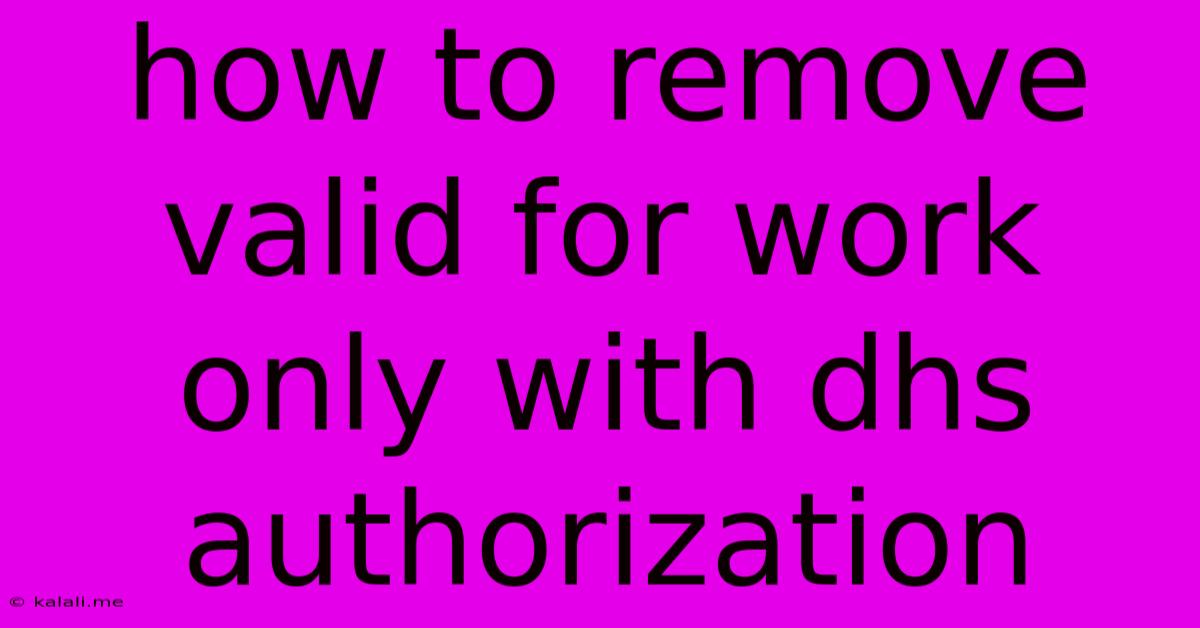How To Remove Valid For Work Only With Dhs Authorization
Kalali
Jun 09, 2025 · 3 min read

Table of Contents
How to Remove "Valid for Work Only" with DHS Authorization: A Comprehensive Guide
Meta Description: Navigating the process of removing the "Valid for Work Only" restriction on your visa with DHS authorization can be complex. This guide breaks down the steps, requirements, and potential challenges, providing a clear path to achieving your goal.
Removing the "Valid for Work Only" restriction from your visa, often associated with DHS (Department of Homeland Security) authorization, requires careful navigation of the immigration process. This restriction limits your ability to engage in activities beyond employment. This comprehensive guide outlines the steps involved, offering clarity on a potentially confusing process.
Understanding the "Valid for Work Only" Restriction
The "Valid for Work Only" endorsement on your visa indicates that your authorized stay in the country is solely for employment purposes. This restriction is often tied to specific work permits or visas, limiting your ability to travel outside the country without specific approval, and restricting your eligibility for certain benefits or activities. Removing this restriction typically requires a change in your immigration status, often requiring additional documentation and a new application.
Steps to Remove the "Valid for Work Only" Restriction
The process for removing this restriction is dependent on your current visa status, the reasons for the restriction, and your desired future immigration status. There's no one-size-fits-all answer, but here's a general outline of the steps involved:
1. Determine Your Current Visa Status and Eligibility:
- Review your visa documentation: Carefully examine your visa and associated paperwork to fully understand the specific restrictions and conditions attached to your current status.
- Consult an immigration attorney: This is crucial. An immigration lawyer can provide personalized guidance based on your specific circumstances, helping you navigate the complex legal landscape and ensuring you submit accurate and complete applications. They can advise on the best course of action for your situation and help you avoid potential pitfalls.
- Research potential visa options: Depending on your goals (e.g., changing jobs, becoming a permanent resident), you may need to explore different visa categories. Research options like H-1B, green cards, or other relevant pathways based on your qualifications and intended activities.
2. Gather Necessary Documentation:
This will vary depending on the visa you're applying for, but generally includes:
- Proof of identity: Passport, national ID, etc.
- Employment documentation: Previous employment history, offer letter for a new job (if applicable), tax returns, etc.
- Financial documentation: Bank statements, proof of sufficient funds to support yourself.
- Educational documentation: Diplomas, transcripts, etc.
- Criminal background check: You may need a clean criminal record.
3. Submit the Appropriate Application:
- Form I-129 (Petition for a Nonimmigrant Worker): If you're seeking a change in your non-immigrant status related to employment.
- Form I-485 (Application to Register Permanent Residence or Adjust Status): If you're pursuing a green card or permanent residency.
- Other forms: Depending on your specific circumstances, other forms may be required. Your attorney can help you identify these.
4. Attend Interviews (If Required):
- US Citizenship and Immigration Services (USCIS) may require an interview as part of the application process. Proper preparation is key to a successful interview.
5. Monitor Application Status:
- Track your application's progress through the USCIS online tracking system.
Potential Challenges and Considerations:
- Processing times: The application process can take considerable time, so patience is essential.
- Rejection possibilities: Applications can be denied for various reasons, including incomplete documentation or ineligibility for the desired visa.
- Legal fees: Immigration legal services can be expensive.
Conclusion:
Removing the "Valid for Work Only" restriction requires careful planning and adherence to the legal procedures. Seeking professional guidance from an experienced immigration attorney is strongly recommended to ensure a smooth and successful process. Remember, thorough preparation and accurate documentation are essential to maximizing your chances of approval. This guide offers a general framework; the specifics will vary depending on individual circumstances. Always consult with an immigration lawyer for tailored advice.
Latest Posts
Latest Posts
-
What Year Would I Be Born If I Was 21
Jul 01, 2025
-
How Many Minutes Are In 40 Hours
Jul 01, 2025
-
How Many Cups Are In 16 Oz Of Sour Cream
Jul 01, 2025
-
How Many Quarters Are In 20 Dollars
Jul 01, 2025
-
How Many 1 3 Cups Equal A Cup
Jul 01, 2025
Related Post
Thank you for visiting our website which covers about How To Remove Valid For Work Only With Dhs Authorization . We hope the information provided has been useful to you. Feel free to contact us if you have any questions or need further assistance. See you next time and don't miss to bookmark.